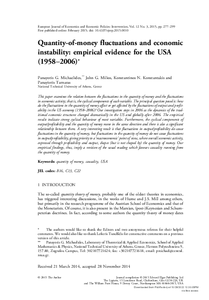Quantity-of-money fluctuations and economic instability: empirical evidence for the USA (1958–2006)

Michaelides, Payanotis G. ; Milios, John G. ; Konstantakis, Konstantinos N. ; Tarnaras, Panayiotis
European Journal of Economics and Economic Policies
2015
12
3
277-299
business cycle ; capital flow ; money supply
Business economics
http://dx.doi.org/10.4337/ejeep.2015.03.03
English
Bibliogr.
"This paper examines the relation between the fluctuations in the quantity of money and the fluctuations in economic activity; that is, the cyclical components of each variable. The principal question posed is: how do the fluctuations in the quantity of money affect or get affected by the fluctuations of output and profitability in the US economy (1958–2006)? Our investigation stops in 2006 as the dynamics of the traditional economic structures changed dramatically in the US and globally after 2006. The empirical results indicate strong cyclical behaviour of most variables. Furthermore, the cyclical components of output/profitability and the quantity of money move in the same direction and there is also a significant relationship between them. A very interesting result is that fluctuations in output/profitability do cause fluctuations in the quantity of money, but fluctuations in the quantity of money do not cause fluctuations in output/profitability, giving priority to a ‘macroeconomic' point of view, where overall economic activity, expressed through profitability and output, shapes (but is not shaped by) the quantity of money. Our empirical findings, thus, imply a revision of the usual reading which favours causality running from the quantity of money."
Digital
The ETUI is co-funded by the European Union. Views and opinions expressed are however those of the author(s) only and do not necessarily reflect those of the European Union or the ETUI.